Which is very different from the look of the native vegetation:
During my tour (with the Minnesota Landscape Arboretum), I visited just two natural areas--the Audubon Corkscrew Swamp Sanctuary and the Conservancy of Southwest Florida---but the contrast to developed Florida was very clear.
Wild Florida had lots of flooded land (call it swamp if it is flooded forest, marsh if it is flooded grassland)
It was February, the end of winter even in south Florida. In contrast to malls and city streets, flowers were few. This expanded lobsterclaw (Heliconia latispatha) is a weed.
 |
| Expanded lobsterclaw in bud, Heliconia latispatha |
My photos are mainly of landscapes because from the boardwalk it was hard to take quality photos of individual plants. (On a return trip I'd look for a track into the vegetation or use a telescopic lens.)
The vegetation is diverse. It changes with elevation, shade, and surely soil, and much of it is sharp-edged or spiny, an added discouragement to visitors, if mud isn't enough.
It isn't surprising, really, that development meant cutting the trees, draining off the water, filling the low spots and replacing the natives. And yet, south Florida is a treasure, an isolated area (three sides water, one side too cold for subtropical species) with plants, animals and ecological communities found only there and nowhere else in the world. Just as wonderful plants from all over the world can be grown in south Florida and nowhere else in the continental U.S., the many natives grow only there. Part of the trick to conserving the native plants and animals in the 21st century is to learn to live with them. Floridians share space with crocodiles and alligators. If they can do that, they can surely grow native plants in their yards, figure how to domesticate their spectacular wild flowers and native shrubs, and encourage native insects. And that is happening.
It was February, I can't show many pictures of flowering natives, but here is blanket flower (Gaillardia pulchella, sunflower family, Asteraceae) quite spectacular and native:
 |
| blanket flower, Gailardia pulchella |
Seagrape (Coccoloba uvifera, buckwheat family, Polygonaceae) is a native coastal shrub with very large leaves (sometimes bigger than my hand) with handsome red veins and grape-like fruits. I saw it as a hedge.
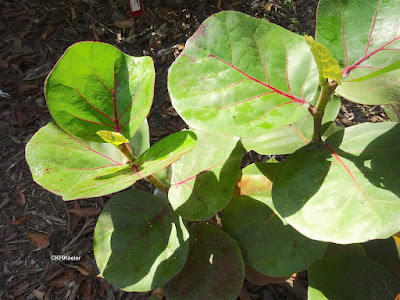 |
| sea grape Cocoloba uvifera |
And yaupon holly, a very pretty, native American shrub (Ilex vomitoria, holly family Aquifoliaceae). Very attractive as an ornamental. Yaupon is probably the only plant native to North America that contains caffeine and my Facebook feed periodically brings me advertisements for yaupon tea. (The species epithet vomitoria is apparently a mistake: the tea does not cause vomiting. The first name validly applied is the correct name, so it would be hard to change.)
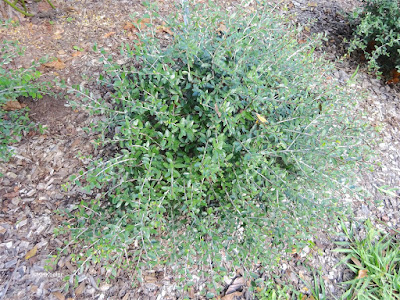 |
| yaupon or yaupon holly, Ilex vomitoria |
The list of plants native to south Florida that make good ornamentals is actually quite long. (Suggestions from University of Florida link). I saw these and others in horticultural settings; south Florida has started to embrace its unique natives.
They have some wonderful success stories. The plant below is coontie, Zamia integrifolia, a cycad (family Zamiaceae, called the sago palm family. Cycads look superficially like palms but are a very much older group of plants, gymnosperms, lacking flowers but producing seeds.) Coontie is native to Florida, southeast Georgia, and the West Indies.
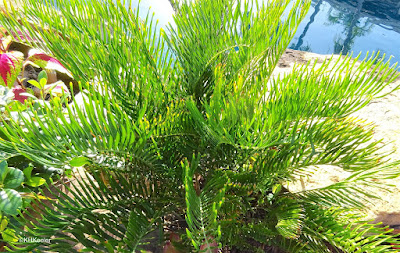 |
| coontie, Zamia integrifolia |
Once widespread and in some places common in Florida, settlers used the roots as a source of starch and severely over-harvested coontie, reducing the plants to widely scattered little stands. Today, wild coontie is protected as an endangered species in Florida, though it is widely planted as an ornamental.
Coontie has a specialist butterfly, the atala butterfly, Eumaeus atala, which eats only coontie. As coontie populations declined, atala butterflies decreased. By the 1950s the atala butterfly was thought to be extinct. In 1979 one was spotted on an island off Miami. A recovery program began!
Floridians began planting coonties and that was what the atala butterfly needed. Coonties are found all over southern Florida and atala butterfly numbers have risen dramatically. The atala butterfly below landed by me, on the top of the staircase at the Conservancy for Southwest Florida, and posed for several photos. Such a beautiful butterfly! and how wonderful to have recovered enough numbers to be seen by a visitor! Some native animals will thrive if we simply grow the plants they require.
Native south Florida was very different from urban and suburban south Florida; it has many wonderful natives worth seeing and preserving.
Comments and corrections welcome.
Sources
Florida Native Plants. University of Florida IFAS Gardening Solutions link
Levine, R. 2016. A nearly extinct butterfly makes a comeback in South Florida. Entomology Today link Accessed 5/8/20/
Culbert, D. F. Florida coonties and atala butterflies. 1995. University of Florida IFAS Extension link
Accessed 5//8/20.
Kathy Keeler, A Wandering Botanist
More at awanderingbotanist.com



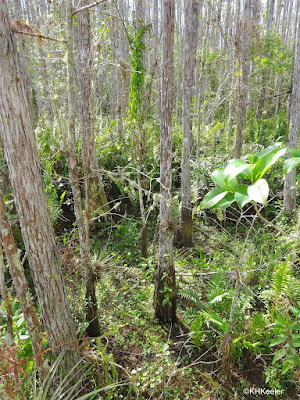

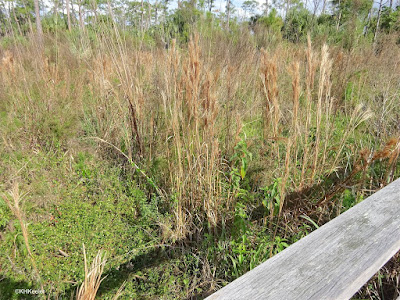
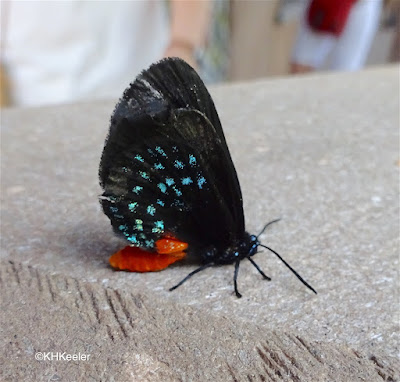
No comments:
Post a Comment